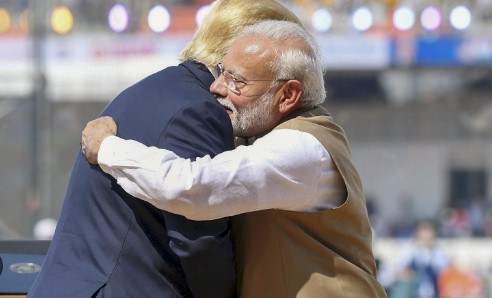India-US Relations Under Trump’s First Term: A Retrospective
 Daniel Dani
Daniel Dani
As Donald Trump potentially returns to the White House, it’s useful to reflect on how his first term shaped India-US relations and consider what it may signal for the future. From defense cooperation to shared concerns over China, “Trump 1.0” saw unprecedented bilateral engagement between the two nations.
Growing Strategic Partnership
During Trump’s presidency from 2017 to 2021, India transformed from a strategic ally to an indispensable partner for the United States. Prime Minister Narendra Modi and President Trump’s close engagement bolstered mutual cooperation, beginning with Modi’s 2017 visit to the White House. This partnership was showcased in Trump’s February 2020 trip to India, where he was welcomed with the grand “Namaste, Trump” event in Ahmedabad, attended by over 100,000 people.
Defense, Counterterrorism, and Energy Collaborations
In the defense arena, India’s procurement from the US surged, with deals reaching an annual value of $18 billion by 2019. Trump’s administration elevated India to Tier I of the Strategic Trade Authorization (STA) list, granting India access to sensitive American defense technologies, a significant departure from past technology restrictions.
Counterterrorism cooperation also flourished. After the 2019 Pulwama attack, the US supported India’s push to designate Jaish-e-Mohammed’s chief Masood Azhar as a global terrorist through the UN Security Council. The US further supported India’s regional security interests by endorsing the Financial Action Task Force’s (FATF) decision to place Pakistan on its “grey list” in 2018.
In energy, the bilateral Strategic Energy Partnership launched in 2018 facilitated India’s first imports of American crude oil and LNG. By 2020, the US became India’s sixth-largest supplier of hydrocarbons, with imports reaching an estimated $6.7 billion.
Trade Friction and Controversial Issues
Despite positive strides, the Trump administration’s America-first stance led to friction. Trump was vocal about India’s tariff policies, particularly on American motorcycles like Harley-Davidson. While bilateral trade in goods and services grew over 10% from 2016-2018 to reach $142 billion, tariff disputes remained a sticking point.
Trump’s immigration policies also created challenges, particularly the limitations on H-1B visas that impacted India’s skilled labor force in the US. Another source of tension was Trump’s unexpected offer to mediate on Kashmir, a sensitive topic for India. Although he later backtracked, his comments briefly unsettled New Delhi.
Common Ground on China as a Strategic Rival
Perhaps Trump’s most lasting legacy on Indo-US relations was his assertive stance on China. The Trump administration revived the Quad — a strategic grouping of India, the US, Australia, and Japan — to counterbalance China’s influence in the Indo-Pacific. Trump’s framing of China as a strategic rival laid a strong foundation for the nations’ shared vision of a free and open Indo-Pacific region.
Concluding Thoughts
Trump’s non-interventionist approach to India’s domestic policies and human rights issues was met with approval in New Delhi. While there were tensions over trade and immigration, the Trump-Modi era marked a high point in defense, energy, and counterterrorism collaboration. As Trump’s potential second term looms, India may anticipate both continuity and renewed focus on strategic challenges in the Indo-Pacific, particularly concerning China.
Subscribe to my newsletter
Read articles from Daniel Dani directly inside your inbox. Subscribe to the newsletter, and don't miss out.
Written by
